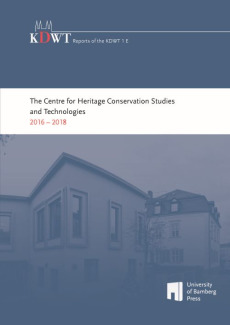The Centre for Heritage Conservation Studies and Technologies (KDWT) 2016 – 2018
Herausgegeben von Stefan Breitling, Herausgegeben von Rainer Drewello, Herausgegeben von Mona Hess, Herausgegeben von Gerhard Vinken, Herausgegeben von Tobias Arera-Rütenik
Reihe: Berichte des KDWTThe Centre for Heritage Conservation Studies and Technologies (KDWT) was founded in spring 2016 as a central research institute of the Otto Friedrich University Bamberg. The core tasks of the KDWT are the expansion of knowledge and technology transfer to non-university research in-stitutions, business and crafts, the expansion of technical excellence, the supplementation of the range of courses, the support in research, teaching, transfer and service in terms of content and technical equipment as well in the internationalisation of research. The centre is divided into four departments: Monument Preservation, Digital Heritage Technologies, Building Research and Res-toration Science and thus covers both the foundations in the humanities as well as engineering and scientific approaches.
The first volume of the “Reports of the KDWT” series presents the technically diverse work of the first two and a half years since the KDWT was established in a format with colour illustrations. Four main chapters represent the four departments mentioned. First, the fundamental aims and focus of each subject are outlined. This is followed by individual presentations of the respective re-search projects, which also would like to bring the content closer to the non-expert reader, especially through the illustrations provided. For a better overview, basic information and thematically linked publications have been added to the projects.
For example, the Monument Preservation department reports on various projects related to the theme, city and heritage conservation, addresses participatory heritage protection, emotions and heritage as well as a municipal monument plan for Bavaria, to name just a few. The digital heritage technologies outline projects in the area of 3D documentation. The building research area analy-ses large medieval buildings, develops concepts for building preservation and improves technical skills in building analysis. Finally, the area of restoration science explains the use of non-destructive methods of investigation and microanalysis based on international and local projects, be they Sin-ghalese temple sites, European cathedrals or medieval textiles from the Bamberg cathedral treasury. The aim of the project presentations is to clarify to what extent each sub-area represents the KDWT with extraordinary, professionally sound experience and expertise in teaching, research and above all in practice.
In order to do justice to the extensive transfer, networking and research activities of the individual members, a fifth main chapter lists all individual services in alphabetical order until mid-2018.

